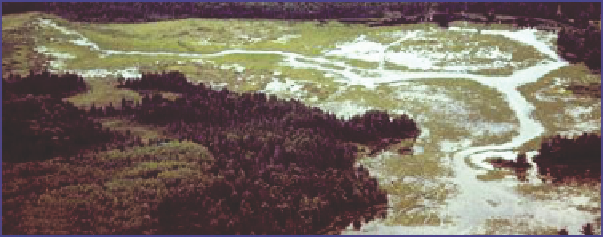Environmental Engineering Reference
In-Depth Information
FIGURE 6.6
Patchy distribution of macrophytes. (From Water on the Web, Monitoring Minnesota Lakes
on the Internet and training water science technicians for the future—A national on-line curriculum using
advanced technologies and real-time data, University of Minnesota, Duluth, MN, 2004. Available at http://
WaterOntheWeb.org. With permission.)
advantage of being able to obtain nutrients from their roots as well. Floating macrophytes limit
light penetration, which also limits the growth of periphyton and phytoplankton. Conversely, exces-
sive phytoplankton growth can cause shading that limits the growth of submerged macrophytes.
Similarly, periphyton growth on the leaves of macrophytes may limit light penetration and limit
macrophyte growth.
The interactions and dominance of particular forms may vary seasonally or as a function of
other conditions. For example, on the Bow River below the city of Calgary, Alberta, macrophytes
commonly dominate primary productivity. Since the river supports a world-class isheries, a variety
of agencies are involved in managing the nutrient loads from the expanding population of Calgary
in order to protect those isheries and the water quality of the river. A part of the target of a total
loading management (TLM) program was focused on the macrophytes. Although periphyton were
present, they were initially assumed to have a secondary impact. However, in 2005, a major lood
event scoured the river, dramatically reducing the macrophyte densities. While following the lood
the macrophyte density was greatly reduced, primary productivity as relected in diel variations in
dissolved oxygen remained relatively unchanged. The cause was attributed to a relatively rapid shift
from a macrophyte-dominated system to a periphyton-dominated system, emphasizing the signii-
cance and previously unrecognized effects of periphyton (Robinson 2007).
6.3 HETEROTROPHS
6.3.1 S
treaM
I
nVertebrateS
There is an enormous variety of invertebrate (animals without a backbone), heterotrophic (consum-
ers) organisms in streams and rivers, as shown in
Pennak's Freshwater Invertebrates of the United
States
(Smith 2001). They vary widely in size and form, and some spend only a portion of their life
cycle in water. Invertebrates include a variety of forms that live suspended in the water column,
such as zooplankton. In contrast, in streams and rivers, particularly those of low order, organisms
typically have to live in or cling to the bottom substrate (the benthos), and these are referred to as
benthic invertebrates. Many of these benthic invertebrates are relatively large, such as mollusks,
worms, insects, and crustaceans, and they are referred to as benthic macroinvertebrates. Some of
the microscopic forms, such as the planktonic forms (zooplankton), are also important, particularly
in higher-order streams, and these will be discussed in more detail in a subsequent chapter on the
biota of lakes and reservoirs.
The benthic macroinvertebrates consume and transform organic matter and aid in the cycling of
nutrients. These organisms are also of importance as indicator species for water quality, as will be
discussed in Chapter 7.

Search WWH ::

Custom Search